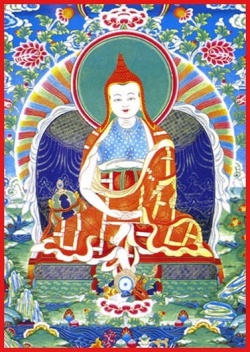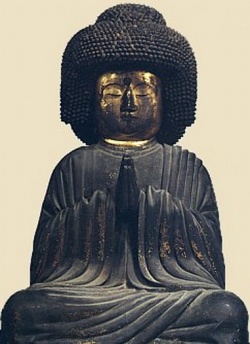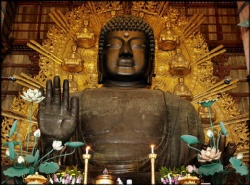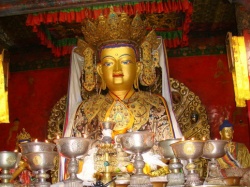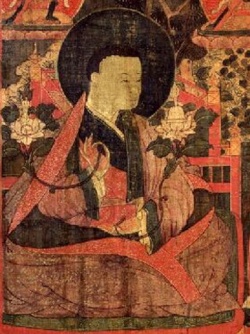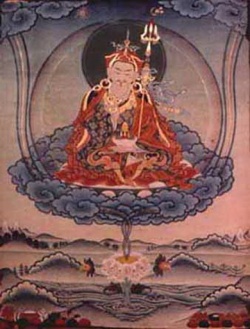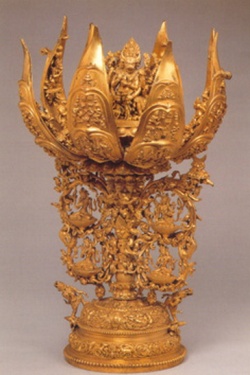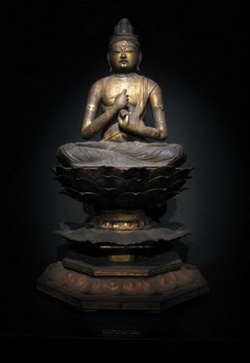Mañjuśrīmitra Incarnation of Divine Wisdom
Manjusrimitra was the intelligent son of an upper class Brahmin from a second grade village to the west of Bodh Gaya. It is said that as a youth he was handsome, with gracious features and clear dark eyes. This fine featured boy, who seemed to deport himself like a young prince, was fair of skin, tanned to a golden hue in India's daily sun. His hair was as black as a raven's back.
Life At Nalanda University
Manjusrimitra was initially taught at home by skilled tutors. When he was well educated at the graduate level, he went to Nalanda University, which was at that time the world's greatest establishment of learning. Nalanda was the end result of a series of endowments initially made by six kings, culminating in the lavish patronage of the great Emperor Harsha. The buildings, many of which were six storied, were majestic in their size and height, with richly adorned towers and observatories seemingly lost in the clouds. A stone inscription of the eighth century describes how the row upon row of six-storied monasteries, each possessed a series of golden spires (sikhara-sreni) seemingly touching the sky. Down below, fair lawns surrounded the buildings, along with a scattering of ornamental ponds, planted with blue lotus and deep-red Kanaka flowers, while at stately intervals Amra groves spread their lush foliage over all, affording cool shade.
The academic area at Nalanda was marked off by a lofty enclosing wall. The four main gates opened into the great college, from which were separated eight other halls, standing in the middle of a vast park. The University provided for all its alumni (without cost) the basic necessities of clothing, food, bedding, and medical care. Education was free. The students being so abundantly supplied with the essential material needs of life, were therefore expected to concentrate whole-heartedly on their education, and the conditions for admission were very strict. Nalanda University was an academy for higher graduate studies.
Nalanda University boasted 1,500 teachers in charge of 8,500 students. The teachers were expected to be able to recite by heart, at minimum, twenty collections of Sutra and Shastra. Of these teachers, about 500 were said to be able to recite and comment on as many as thirty such collections. There were about ten from amongst the teachers who knew as many as fifty collections, and these latter were viewed, as we can well imagine, with special awe. But above all of these, we are told, were four seniors, who resided in the four Gate-houses at the four quarters of the University cantonment. These last were considered the most learned of all.
Huang Tsiang, a Chinese monk who visited Nalanda University during his pilgrimage to India, tells us that all the alumni "dwelling here are, as a body, naturally or spontaneously dignified and grave, so that during the 700 years since the foundation of the establishment, there has been no single case of guilty rebellion against the rules."
We also know that the courses of study offered at the University covered virtually the entire range of world knowledge then available. Courses were drawn from every field of learning, Buddhist and Hindu, sacred and secular, foreign and native. Students studied science, astronomy, medicine, and logic as diligently as they applied themselves to metaphysics, philosophy, Samkhya, Yoga-shastra, the Veda, and the scriptures of Buddhism. They studied foreign philosophy likewise.
Amongst the residents, and the staff, there were persons of various affiliations: there were of course the great body of Buddhist monks, but also the worshippers of Krishna, the white robed Saivites, the Samkhyists, the Materialists (Lokayatikas), the Vedantins, and those of foreign lands: the Yavanas (Greeks), the [[Wikipedia:Central Asian|Central Asian]]s, and the Chinese. Undoubtedly Christian and Manichaean missionaries could match argument with Brahmanist or Ceylonese savant, and Magi could confer with Turkhoman, in perfect tolerance.
Nalanda University became the common meeting-ground for all sects and beliefs, for every kind of philosophy and science, where in its daily "tournaments of discussion" every rational and irrational doctrine could be tested in an environment run on humanistic principles. A philosophical opinion or scientific discovery at once approved and recognized at Nalanda would immediately acquire universal respect. To win a debate at the University was therefore a prize much sought after.
But the scholastic atmosphere, fired by animated controversies between divergent schools of thought, was not the University's sole pre-occupation. Before it was an academy, Nalanda was a monastery – indeed, a group of monasteries, juxtaposed in harmony. Those who enrolled in the University lived their term as monks, recognizing in the midst of the various intellectual differences of the age, a higher ideal capable of evolving a common vision founded on the spirit of mystical contemplation.
Manjusrimitra, ordained as a Buddhist monk, studied for some ten years at this seat of extraordinary culture and learning. Having graduated with honors from the basic curriculum, he acquired the renown of a Pandit, or scholar. His brilliance was rewarded with a teaching post.
Then by degrees, he advanced to the position of Mahapandita and became one of the venerated Gate-holders of the University. Finally he was unanimously acclaimed the leading scholar of the whole academy, and hence really of the whole world in that era, with the title of supreme Patriarch (Kulapati). He was particularly learned in the Madhyamaka (Middle Way) philosophy expounded by the brilliant first century Buddhist sage Arya Nagarjuna.
The Great Debate
One day a learned man named Manjusritiksana came to Nalanda University and proclaimed in front of the Patriarch Manjusrimitra, "O noble lord, if you want to acquire Great Enlightenment in this your present lifetime, then you must go to the Sitavana cremation ground near Bodh Gaya! There is a saintly Guru there who expounds the nondualist doctrine."
Now, this message did not exactly please Manjusrimitra at all! Initially the great Patriarch was far from open to meeting with Sri Pramodavajra. From much of what he had heard, he expected the Master to be the exponent of doctrines fundamentally at odds with what he considered to be true Buddhist philosophy. The Mahapandit Manjusrimitra represented the classical, scholastic tradition of Madhyamaka. He was the uncontested head of the great monastic University of Nalanda, and thus representative of a long historical scholarly line that considered itself the pinnacle of orthodoxy. He viewed anything to do with Yogacara as a false doctrine.
Nor was doctrine the only issue at stake. Compared to the saffron-robed monks, whose lives were meant to stand for impeccable virtue and chastity, the Guru Pramodavajra was a vagabond Yogi-saint, a popularly acclaimed white-robed Siddha, who lived with a woman consort, and practiced meditation in a charnal ground strewn with the ghastly remnants of the dead.
When the powerful Mahapandit went out to see Sri Pramodavajra for the first time, it was with a full retinue of admiring followers, and with the plain intention of engaging the Yogi-Master in a debate that would put him to shame.
The history books of our Tradition do not tell us how the august Patriarch traveled from Nalanda to the Cool Grove cremation ground of Bodh Gaya, but from other texts we do know that the University was duly mindful of the dignity that should belong to the position of its official Patriarch. The company would therefore have formed an imposing procession, carrying standards, parasols, flower garlands and perfume sprinklers, accompanied by young novices swinging smoking incense censors. At the head of this grand assembly would have been the great Patriarch Manjusrimitra himself, in full splendor, dressed in magnificent golden coloured robes, seated on a noble elephant. Upon arrival, a formal throne would have been erected for the distinguished Mahapandit. As many as twenty lesser Pandits, noted for their dignified bearing, would then have escorted the Master Pramodavajra into the august presence of their Patriarch. After formal introductions, Manjusrimitra would presumably have opened the debate with a broad attack from the Madhyamaka position. We know that the Patriarch expected to win hands down.
Of course, quite the opposite happened. It was the Great Pandit who looked the fool, and whose vaunted knowledge proved empty in the presence of Sri Pramodavajra's penetrative wisdom. With masterful answers the Saint quietly laid Manjusrimitra's arguments bare, and showed how shallow is purely intellectual knowledge when faced with the direct experience of actual Enlightenment. The most learned scholar Manjusrimitra had come like a general to do battle, only to fall conquered before the invincible insight of the living saint.
Thus the Master is said to have tamed the great scholar and brought him within sight of seeing his own true nature.
After his defeat, all that Manjusrimitra could do was admit his subtle egoism and the exposed limits of his knowledge. He sat at the feet of the Master and begged to become a disciple.
This humble but truly honest act of submission to the Master scandalized many of the lesser scholars of the Patriarch's entourage. We read in the history books that the majority of those that went forth that day to witness the debate, turned away from their Patriarch when he submitted to Sri Pramodavajra. The crowd of fools marched back to Nalanda, leaving the defeated Manjusrimitra to his new life.
In general people need the institutions that support their position in the world. Consequently they fiercely hold to the ideological concepts belonging to those institutions. Desiring a stable frame of reference, they cling to whatever fixed system of beliefs that confirm meaning for them. Once satisfied with such a set of concepts and beliefs, it becomes next to impossible for them to change. A full mind and heart, like a full stomach, no longer feels the need to seek anything more. Thus people close themselves to the spiritual quest.
The scholars of Nalanda University left their Patriarch because he could no longer serve their need of lending authority to a system of beliefs that he no longer saw as true.
Living in Dependence on the Guru
In defeat, the great sage Manjusrimitra was bereft of those intellectual constructs that until then had supported his view of life. He became, as it were, an empty vessel ready to receive utterly fresh, direct insight. Into that open cup the Master poured his illuminated spirit of truth.
Sri Pramodavajra began the re-education of Manjusrimitra by instructing him as follows:
"The nature of your own mind-essence is, from the very beginning, none other than Buddha. This mind, in and of itself, is both birthless and deathless. It is simply like the sky. If the intrinsic truth of the nonduality of all phenomena is understood in its totality, and if this view is merely sustained in faith, without making any kind of effort, then that is how one should practice meditation."2
On another occasion Sri Pramodavajra said:
"Remain aware as thoughts arise, remain aware if thoughts do not arise: there is no difference in Awareness in either case."
Holding to these preceptsa proceeded to live in dependence on the Guru, merely sustaining remembrance without making any effort to control or incline the mind. Consequently, in rapid succession, and through the sublime grace of the compassionate Master, the lotus-like petals of the delicate bud of Manjusrimitra's inner heart opened up, revealing the central sun of the eternal Buddha within. With the sharp diamond point of the profound teachings of Absolute Totality (mahasamdhi), which immediately reveals the authentic ground of reality just as it is, and without any hesitation or meandering, he rapidly awoke to the Light.
Manjusrimitra had been like a ripe fig ready to fall from the tree of Enlightenment when he first met his divine Guru. His years at Nalanda studying the Dharma had prepared him well. It therefore did not take much for him to be led to see the nature of mind. In short order he attained Enlightenment. Aided by perfect instruction, the disciple thus became equal to the Master. Even then he continued to serve the Guru, with complete love and joy.
Thus Manjusrimitra came to dwell in a supreme state of transcendental bliss. He became Pramodavajra’s leading disciple—his gyaltsap or lineage heir. And so over the years, the aging guru and leading disciple, surrounded by devotees and friends, traveled about India, bringing blessings and light to innumerable beings.
Sri Pramodavajra's Death and Resurrection
As is the fate of all, with time Sri Pramodavajra's body could no longer sustain life, and he passed away. Manjusrimitra was stricken with grief. Although he perfectly well knew that in reality the immutable essence of mind is neither born nor dies, nevertheless out of the passion of his human love for the Guru, Manjusrimitra's heart wept, desiring the human personality and physical presence of Pramodavajra that he had grown to so deeply care for. Overcome, he prayed to his beloved Master, refusing to believe that death could sever the bond of intimacy that had grown so strong over the years.
And lo, how greatly did Manjusrimitra's grief turn to holy pleasure, when during the solemn cremation rites, Sri Pramodavajra's resurrected bodily form, so dear to his disciple, appeared before him amidst the flames, transfigured within a translucent sphere of pure radiant light!
It is said that, in what was a final act of selfless communion, and before ascending forever beyond this finite, mortal world of matter, the momentarily resurrected form of Pramodavajra miraculously placed into Manjusrimitra's trembling hands a small but concretely physical casket fashioned from gold-metal, containing the divine Master’s last testament. This it is that is known as the Three Statements Pointing to Absolute Awareness.
We are told that this final miraculous gift of the Master destroyed for ever the last traces of Manjusrimitra's instinctual fear of death—his final fear of separation and loss in this world. He became, at that moment, instantly and completely liberated. Full enlightenment was then his.
Henceforth, says sacred history, no separation existed between Manjusrimitra's consciousness and the immortal presence of his beloved spiritual father. Now disciple and master existed one and the same, in a wholly mystical state of union, as the individual dew drop of finite personhood "slipped silently into the shining sea"3 of infinitude, to become inseparable with Buddha-Absolute.
It should not be thought incredible that Pramodavajra appeared in an actual body of resurrection after his death. Similar stories are recorded of other great saints, such as Jesus, Milarepa, Kabir, Sri Simha, Padmasambhava, and Ju Mipham Namgyal. St. Paul, who once persecuted the apostles of Jesus because they believed in their own Master’s resurrection, eventually became so convinced of this fact that he wrote
"So when this corruptible shall have put on incorruption, and this mortal shall have put on immortality, then shall be brought to pass the saying that is written: 'Death is swallowed up in victory."4
Likewise Manjusrimitra is said to have briefly appeared in physical form to at least one of his disciples after his death.
After Sri Pramodavajra's passing, the Master Manjusrimitra went to live in the Sosadwipa cremation ground that was to the west of Bodh Gaya, where he taught many Yogis and Yoginis and other spiritual practitioners. There he produced a fresh redaction of Sri Pramodavajra’s doctrine, which it is said, had been composed in 6,400,000 slokas and stored in the archives of the Dakini-abhivyakta-bhava Cave Temple, under the care of a certain abbess named Lady Cittasana.5 This new redaction he supposedly reduced to a more available form, by dividing the original into three categories: a Mind section, Space section, and Esoteric Instruction section.6
Sometime after that, Manjusrimitra settled down to live with a beautiful woman named Sri Devi, the widow of a peasant farmer. Her first marriage had been arranged, as is so often the custom in India. But her second marriage to the Master Manjusrimitra was sanctified by true love. The two lived happily on their little farm near Bodh Gaya for the rest of their lives.
Sri Manjusrimitra spent his days performing quite ordinary duties around the farmyard, or else merely relaxing in contemplative ease on one or other of the two charpoys that were set out on the hard packed earth yard in front of their one-roomed adobe hut, where shade was afforded by a single, rather sparse tree. Here in the cool of a tropical evening, a number of devout disciples would usually gather for discussion and meditation, or to sing prayerful bhajans. Some would come from great distances to enjoy darshan (audience) of the renowned master and his saintly wife. There were at these evening gatherings devotees who thought of themselves as Buddhist, and others who considered themselves Hindu. All assembled together in perfect tolerance and harmony, regardless of caste or sect.
Such is the life story of Manjusrimitra, one of India’s greatest yogi-saints.
Footnotes
1 The name Manjusrimitra means "Friend of Manjusri". The Bodhisattva Manjusri is the archetypal embodiment of all the wisdom of the Buddha. Manjusrimitra is looked upon by some as an incarnation of the Bodhisattva Manjusri, who later reappears as the Kunpal Rinpoche. It is obscure whether he came from a "second rate village" (rim.pa.gnyis.pa'i.grong), or from a village named The Two Stages (Dvaparakrama). That Manjusrimitra primarily went to see Pramodavajra with the intention of overthrowing him in debate is described in the rJe btsun thams cad mkhyen pa Be ro tsa na'i rnam thar 'dra 'bag then mo. There were many large, traditional monasteries around Bodh Gaya, and it is conceivable that when Pramodavajra "pitched his camp", so to speak, at Sitavana, rumors would have spread. It would be surprising if the leading scholars of the area did not go out to the cremation ground with the hope of proving, in debate, the error of Pramodavajra's new doctrine.
2 In the Mahasamdhi-yogacara tradition, this type of statement, when given by an Enlightened Master, is known as a "Direct Introduction" to the true nature of Reality, or the true nature of one’s mind. There is a very old tradition that once upon a time Buddha Sakyamuni, seated before a great gathering of all his disciples, silently held up a flower. No one understood the gesture, except the disciple Mahakasyapa, who at the very instant recognized it as a form of direct pointing out of the true nature. Seeing a smile of recognition on Mahakasyapa's face, the Buddha said to him: "O Mahakasyapa, this treasure of seeing the true Dharma, which is the Buddha's wonderful knowing of non-verbal Reality, has hereby been entrusted to you!" The silent holding up of the flower was, for Mahakasyapa, a direct introduction. For Manjusrimitra, the Master's concise words were likewise a direct introduction. However, it is important to understand that it is not merely the holding of a flower or the utterance of certain words, but rather the heart to heart transmission, psychically, that causes the introduction to occur.
3 The line "the dew drop slipped into the shining sea" is from Sir Edwin Arnold, a Victorian era Buddhist and author of the beautiful poem The Light of Asia. Arnold coined the phrase to describe the passing of the Buddha into final Nirvana. Western scholars of his period were concerned that the Buddhist term nirvana meant complete extinction of psychic existence, whereas infact it means the extinction not of mind, but of worldly suffering and personal egoic limitation. Arnold likened the concept to an individual drop of water merging with the whole ocean, which admittedly is more of a Yoga Vedanta image than a Buddhist one. Buddhism teaches that the sense of an individual ego is an error, and that Enlightened Mind (bodhicitta) is one's true condition. However, the awakening (bodhi, enlightenment) of the insight that one's true psychic identity is nothing other than the non-dual Absolute (buddha), does not mean that the whole continuum of one's personal experiences are ever lost. On the contrary, every experience since the beginning of time, is forever part of the non-dual absolute totality of all that constitutes Absolute Being.
4 1 Corinthians 15:54-55
5 This would have been one of the cave temples of the Salt Range. Not far from Ketas there are the signs of destroyed monastic sites and old caves, scattered throughout the imposing red sandstone hills. From ancient times Buddhists have used natural and rock-cut caves as temples. It is obvious that the Dakini-abhivyakta-bhava cave temple of our story was occupied by women and must have been a convent located on the slopes of Mt. Malaya. Its present location remains unknown.
6 6 These three sections are known respectively as Sem-de, Long-de and Men-ngak-de in Tibetan. There are 21 basic tantras of Sem-de, and seven main tantras of Long-de. Men-ngak-de is the largest catagory, with seventeen basic tantras, one Tro-ma tantra, four volumes of profound instruction, and 119 treatises of further instruction. However, modern critical scholarship questions whether all these texts factually represent the literature of the early period, and it well may be true that much of the material now found in the Long-de and Men-ngak-de portions of the canon were added at a later date. The single text that unquestionably expresses the doctrine of Manjusrimitra is the Bodhicittabhavana.
